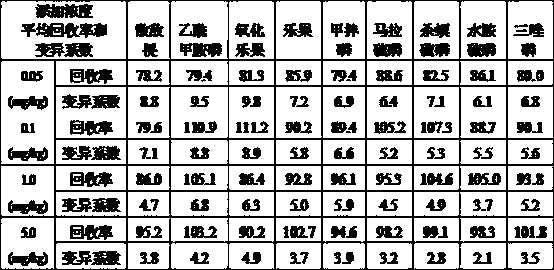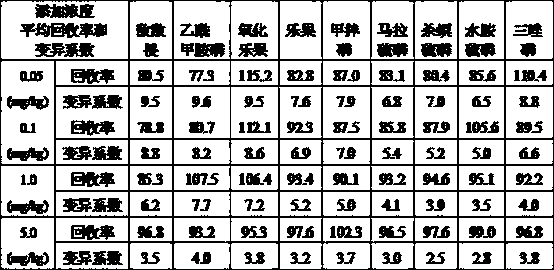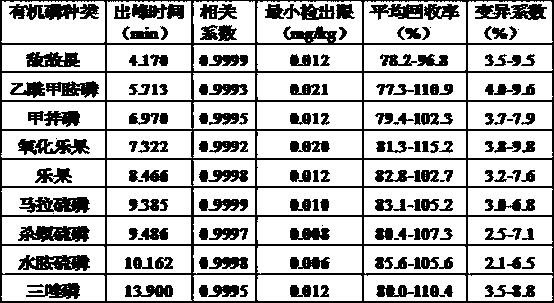Gas chromatographic method for detecting residue amount of nine kinds of organophosphorus pesticide in rice
A technology of organophosphorus pesticides and gas chromatography, which is applied in the field of pesticide residue detection, can solve the problems of long time consumption, low efficiency, complicated extraction and purification process, etc., and achieve the effect of simplifying the sample pretreatment steps, good separation effect and shortening the detection time
- Summary
- Abstract
- Description
- Claims
- Application Information
AI Technical Summary
Problems solved by technology
Method used
Image
Examples
Embodiment Construction
[0030] Mode 1: Detection of 9 organophosphorus pesticide residues in indica rice
[0031] (1) Sample pretreatment
[0032] ①Extraction Use an electronic balance to accurately weigh 10.0 g of the sample into a 250 ml beaker, add 20.0 ml of distilled water to soak for 30 min, then add 40.0 ml of acetonitrile, homogenate at 8000 rpm for 2 min at high speed, then filter with quantitative filter paper, and collect the filtrate Put it into a 100ml stoppered measuring cylinder filled with about 7 g of sodium chloride, collect the filtrate, cover the stopper, shake vigorously for 2 minutes, and let stand at room temperature for 40 minutes to separate the acetonitrile phase and the water phase;
[0033] ② Concentrate and draw 10.0 ml of acetonitrile solution into a 10.0 ml graduated test tube, put the test tube into the water bath of the nitrogen blowing instrument, control the temperature of the water bath at 45°C-50°C, and then stick the stainless steel ventilation needle of the nitr...
PUM
 Login to View More
Login to View More Abstract
Description
Claims
Application Information
 Login to View More
Login to View More - R&D
- Intellectual Property
- Life Sciences
- Materials
- Tech Scout
- Unparalleled Data Quality
- Higher Quality Content
- 60% Fewer Hallucinations
Browse by: Latest US Patents, China's latest patents, Technical Efficacy Thesaurus, Application Domain, Technology Topic, Popular Technical Reports.
© 2025 PatSnap. All rights reserved.Legal|Privacy policy|Modern Slavery Act Transparency Statement|Sitemap|About US| Contact US: help@patsnap.com



